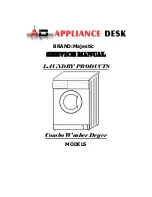
9
PREPARING AND LOADING DISHES
Dish Preparation
Scrape away large pieces of food, bones, pits,
toothpicks, etc. The continuous filtered wash system will
remove remaining food particles. Burned-on foods
should be loosened before loading. Empty liquids from
glasses and cups.
Foods such as mustard, mayonnaise, vinegar, lemon
juice and tomato based products may cause
discoloration of stainless steel and plastics if allowed to
sit for a long period of time. Unless the dishwasher is to
be operated at once, it is best to rinse off these food
soils.
• Load racks so that large items do not prevent the
detergent dispenser from opening.
• Check manufacturer's recommendations before
washing items in question.
• If the dishwasher
drains into a food
disposer,
be sure
disposer is
completely
empty before
starting
dishwasher.
Loading the Top Rack
Features and appearance of racks and silverware basket
may vary from your model.
The upper rack is designed for flexibility in loading a
wide variety of items including cups, glasses, stemware,
small plates, bowls, etc.
Load glasses in top rack. Damage may occur if placed in
bottom rack.
Load plastic items in top rack only. Melting may occur if
placed in bottom rack.
Load items with open ends facing down for better
cleaning and draining.
Damage may occur if delicate items touch each other
during dishwasher operation.
10 place settings standard loading pattern
12 place settings standard loading pattern
(For best washing performance, the upper rack should
be in the raised position.)
(For best washing performance, the upper rack should
be in the raised position.)
Use the Versa-Tray for long-handled knives and utensils.
Be sure nothing protrudes through the bottom of the rack
to block rotation of middle spray arm.
Some models have a fold-down cup shelf or a cup shelf/
stemware holder. They can be used to load two levels of
cups, juice glasses, and other short items. Stagger items
on upper level so that water can reach all inside
surfaces. Fold up to load tall glasses.






































